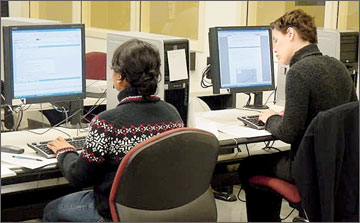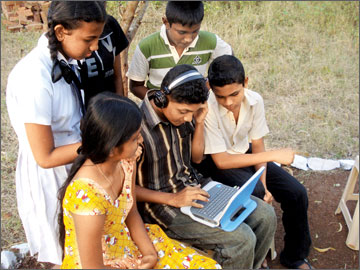|
With recent tax incentive:
Computer market grows at double digit
By Shirajiv Sirimane

Students at a computer class |
 |
The Sri Lanka computer market is growing at a double digit rate and
the recent tax incentive too would help the industry to grow in a bigger
way.
The e-Sri Lanka program launched by President Mahinda Rajapaksa to
increase the IT literacy and increase its penetration especially in the
rural areas along with the Nanasela initiatives too has contributed for
this positive sentiment. Progress is expected over the five-year
forecast period, with internet penetration reaching 26%, and broadband
penetration 13%.
Though Sri Lanka’s IT market which is less than five percent of
India, is estimated to be around Rs. 36 billion and growing in the
excess, of Rs. 7 million annually. It is projected that this market
would grow in the excess of 20 percent which would make Sri Lanka, one
of the fastest-growing markets in the region.
Moves by the government to set up industries in rural areas to breach
the regional disparity too would help to swell the local IT market and
also bring in new investors. “One of the biggest advantages in Sri Lanka
for the IT market is the high literacy rate the country is enjoying,
said an IT Expert from a leading multi national company.
In 2010, the consumer PC segment will benefit from lower interest
rates and more credit availability, while the Computers for Educational
programs will continue to receive government investment in 2010. The
decision by the government to reduce import duties on electronic goods
by around 3.5% should result in a further reduction of local market PC
prices. The move will lead to a reduction in tax on imported CPUs, thus
leading to lower prices for locally assembled computers.
In 2010, the government plans to roll out another 1,500 computer labs
for Sri Lankan schools. This is in addition to the 3,500 that have
already been constructed in both rural and urban areas, with around
6,000 planned in total, a survey by Companiesandmarkets.com had stated.
Sri Lanka’s addressable computer hardware market is estimated at
US$233mn in 2010 and is projected to reach around US$467mn in 2014. At
least 350,000 computers were sold in Sri Lanka in 2009, despite the
economic slowdown. This annual total could increase to more than 650,000
by the end of the forecast period with growing demand for affordable
notebooks.
Sri Lankan spending on software remains rather low, with an estimate
of the addressable market at US$40mn in 2010. IT services are estimated
at around US$62mn in 2010, accounting for about 17% of Sri Lanka’s total
spending on IT. The market is dominated by demand from government,
finance and telecoms sectors, which account for at least half of total
spending.
Greater economic stability in Sri Lanka will enable an expansion of
domestic computer production. In May 2010, Sri Lankan manufacturer,
Singer launched its new Singer X series of affordable notebooks and
netbooks in the domestic market, targeted at rural users. A number of
other Sri Lankan PC brands, including Panora, Maya and Kobian, have
established a niche in the domestic market.
In 2010 Microsoft Sri Lanka is promoting its cloud-computing
solutions, which it believes could be a transformative software delivery
model for Sri Lankan enterprises. Hirdaramani Group, one of Sri Lanka’s
largest apparel manufacturing companies, recently announced that it was
running a cloud computing pilot on Windows Live Initiative. |

